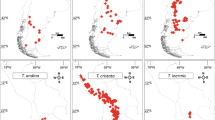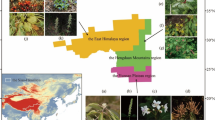Abstract
A hypothetical biogeographical history of northeastern Asiatic soricine shrews in the late Quaternary was developed by integrating their present distributions, fossil records, a hypothetical phylogeny, and geological investigations. First, a biological area cladogram of the northeastern Asiatic region was constructed by applying the vicariance hypothesis to the phylogeny of thecaecutiens/shinto group, a monophyletic group proposed by Ohdachi et al. (1997). Comparing the biological area cladogram with a geological hypothesis by Ohshima (1990,1991,1992), we hypothesized a geographical history of northeastern Asia. Species were then located on the dendrogram of the geographical history, referring to the present distributions, fossil records, and phylogeny of shrews. According to our hypothesis, higher species diversity of the northern region of northeastern Asia (Hokkaido, Sakhalin, and Eastern Siberia) was achieved by several series of colonizations and habitat expansion. On the other hand, the shrew communities of the southern region (Honshu, Sado, Shikoku, and Kyushu) were created by extinction and isolation followed by speciation.
Similar content being viewed by others
References
Abe, H. (1961) Two rare mammals obtained in Hokkaido.Journal of the Mammalogical Society of Japan 2: 3–7.
Abe, H. (1967) Classification and biology of Japanese Insectivora (Mammalia) I. Studies on variation and classification.The Journal of the Faculty of Agriculture, Hokkaido University 55: 191–269.
Abe, H. (1985) Classification, distribution and ecology of the Soricidae, considered from the standpoint of adaptive radiation, pp. 20–37. In K. Kondo (ed.)Suncus. Biology of Soricids as experimental animas. Gakkai Syuppan Center, Tokyo, (in Japanese with English abstract)
Abe, H., N. Ishii, Y. Kaneko, K. Maeda, S. Miura and M. Yoneda (1994)A pictorial guide to the mammals in Japan. Tokai University Press, Tokyo, (in Japanese)
Brooks, D. R. and D. A. McLennan (1991)Phytogeny, ecology, and behavior. A research program in comparative biology. The University of Chicago Press, Chicago.
Brooks, D. R. and D. A. McLennan (1993) Historical ecology: examining phylogenetic components of community evolution, pp. 267–280. In R. E. Ricklefs and D. Schluter (eds.)Species diversity in ecological communities. Historical and geographical perspectives. The University of Chicago Press, Chicago.
Churchfield, S. (1990)The natural history of shrews. A & C Black, London.
Corbet, G. B. and J. F. Hill (1986)A world list of mammalian species, 2nd edn. British Museum (Natural History), London.
Dobson, M. (1994) Patterns of distribution in Japanese mammals.Mammal Review 24: 91–111.
Dolgov, V. A. (1985)Shrews in the north, south, east and west. Moscow University Press, Moscow, (in Russian)
Fairbanks, R. G. (1989) A 17,000-year glacia-eustatic sea level record: influence of glacial melting rates on the Younger Dryas event and deep-ocean circulation.Nature 342: 637–642.
Han, S.-H. (1994) Mammals in North Korea.Nature Conservation (Seoul)86: 44–50. (in Korean)
Hanski, I. (1985) What does a shrew do in a energy crisis? pp. 247–252. In R. M. Sibly and R. M. Smith (eds.)Behavioural ecology: ecological consequences of adaptive behaviour. Blackwell Scientific Publications, Oxford.
Hanski, I. (1986) Population dynamics of shrews on small islands accord with the equilibrium model.Biological Journal of the Linnean Society 28: 23–36.
Hasegawa, Y. (1966) Quaternary small mammalian fauna from Japan.Kaseki (Fossils) 11: 31–40. (in Japanese)
Hasegawa, Y., Y. Tomita, N. Kohno, K. Ono, H. Nokariya and T. Uyeno (1988) Quaternary vertebrates from Shiriya area, Shimokita Peninsula, northern.Memoirs of National Science Museum (Tokyo) 21: 17–36. (in Japanese)
Hutterer, R. (1993) Order Insectivora. pp. 69–130. In D. E. Wilson and D. M. Reeder (eds.)Mammal species of the world. A taxonomic and geographic reference, 2nd edn. Smithsonian Institution Press, Washington DC.
Jones, J. K., Jr. and D. H. Johnson (1960) Review of the insectivores of Korea.University of Kansas Publications, Museum of Natural History 9: 551–578.
Kamei, T., Y. Kawamura and H. Taruno (1988) Mammalian stratigraphy of the late Neogene and Quaternary in the Japanese Islands.Memoirs of the Geological Society of Japan 30: 181–204. (in Japanese with English abstract)
Kawamura, Y., T. Kamei and H. Taruno (1989) Middle and late Pleistocene mammalian faunas in Japan.Daiyonki Kenkyu (The Quaternary Research) 28: 317–326. (in Japanese with English abstract)
Kobayashi, I. and M. Tateishi (1992) Neogene stratigraphy and paleogeography in the Niigata region, central Japan.Memoirs of the Geological Society of Japan 37: 53–70. (in Japanese with English abstract)
Krivosheev, V. G. (1984)Terrestrial mammals in the Far East of the USSR. Nauka, Moscow, (in Russian)
Kurentsov, A. I. (1959)The animals of the Amur and Ussuri regions. Khabarovskoe Kniznoe Isdatelstvo, Khabarovsk, (in Russian)
Macdonald, D. (1984)The encyclopedia of mammals. Facts on File, New York.
McNab, B. K. (1991) The energy expenditure of shrews, pp. 35–46. In J. S. Findley and T. L. Yates (eds.)The biology of the Soricidae. The Museum of Southwestern Biology, University of New Mexico, Albuquerque.
Ohdachi, S., R. Masuda, H. Abe, J. Adachi, N.E. Dokuchaev, V. Haukisalmi and M. C. Yoshida (1997) Phylogeny of Eurasian soricine shrews (Insectivora, Mammalia) inferred from the mitochondrial cytochromeb gene sequences.Zoological Science 14: 527–532.
Ohshima, K. (1990) The history of straits around the Japanese Islands in the late-Quaternary.Daiyonki Kenkyu (The Quaternary Research) 29: 193–208. (in Japanese with English abstract)
Ohshima, K. (1991) The late-Quaternary sea-level change of the Japanese Islands.Chigaku Zasshi (Journal of Geography) 100: 967–975. (in Japanese with English abstract)
Ohshima, K. (1992) Sealevel and coastal morphology through the late Quaternary glacial maximum.Chishitsu News 459: 40–48. (in Japanese)
Ono, Y. (1991) Glacial and periglacial paleoenvironments in the Japanese Islands.Daiyonki Kenkyu (The Quaternary Research) 30: 203–211.
Ota, K. and T. Kobayashi (1984) The origin of wild rodents in Hokkaido, pp. 21–46. In K. Ota (ed.)Study on wild murid rodents in Hokkaido. Hokkaido University Press, Sapporo, (in Japanese)
Ota, Y. and H. Machida (1987) Quaternary sea-level changes in Japan, pp. 182–224. In T. J. Tooley and I. Shennan (eds.)Sea-level Changes.Special publications series No. 20. Basil Blackwell, Oxford.
Stroganov, S. U. (1957)Mammals of Siberia. Insectivora. Science Academy of USSR., Moscow, (in Russian)
Thomas, O. (1905) The Duke of Bedford’s zoological exploration in eastern Asia. I. List of mammals obtained by Mr. M. P. Anderson in Japan.Proceeding of the Zoological Society of London 2: 331–363.
Tomita, Y. and H. Sakura (1991)Catalogue of small mammal (Insectivora, Lagomorpha, Chiroptera, and Rodentia). Fossil specimens. National Science Museum, Tokyo.
Velizhanin, A. G. (1976) The time of the islands’ isolation in the north part of the Pacific Ocean.Dokulady Akademii Nauk SSSR 231: 205–207. (in Russian)
Wiley, E. O. (1981)Phylogenetics. The theory and practice of phylogenetic systematics. John Wiley and Sons, New York.
Wiley, E. O. (1988) Parsimony analysis and vicariance biogeography.Systematic Zoology 37: 271–290.
Author information
Authors and Affiliations
Corresponding author
Rights and permissions
About this article
Cite this article
Ohdachi, S., Masuda, R., Abe, H. et al. Biogeographical history of northeastern Asiatic soricine shrews (insectivora, mammalia). Res Popul Ecol 39, 157–162 (1997). https://doi.org/10.1007/BF02765261
Received:
Accepted:
Issue Date:
DOI: https://doi.org/10.1007/BF02765261




